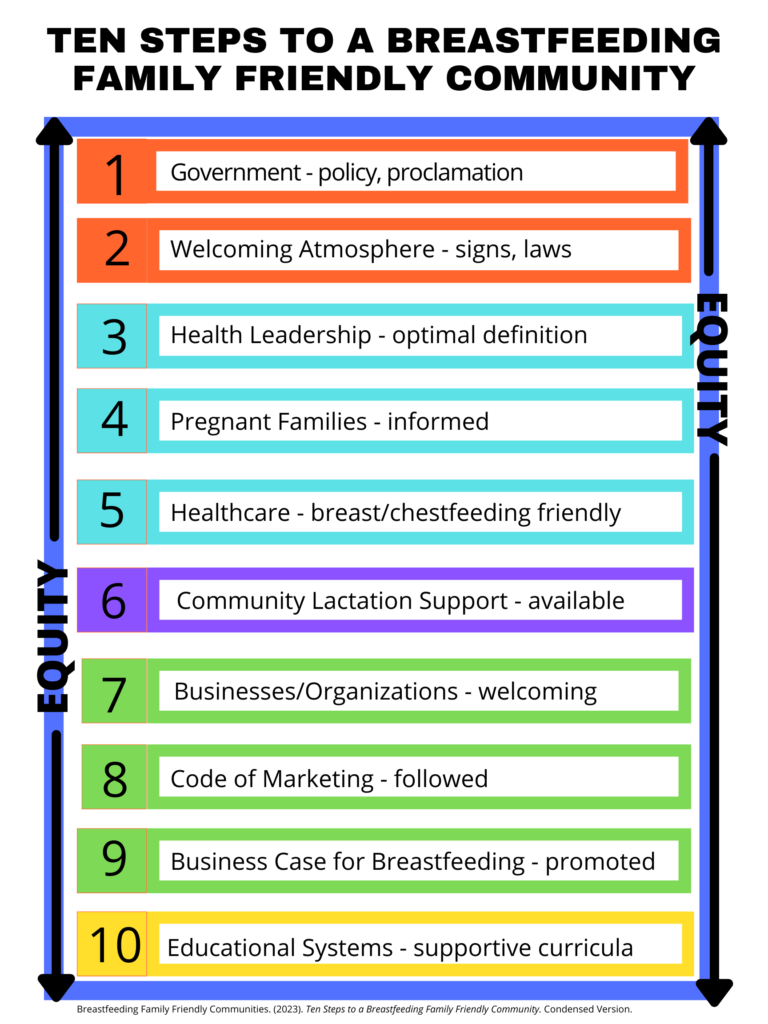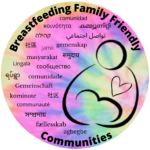The Breastfeeding Family Friendly Communities (BFFC) initiative is a community-wide program to impact Health Equity! We want to ensure that every family receives education and support that does not undermine a family’s decision to chestfeed/breastfeed, but rather enables the family to nurse for as long as that family chooses.
Creating a New Community
- Review the Designation
- Complements and expands on the World Health Organization Baby-friendly hospital guidelines
- Review the Ten Steps to a Breastfeeding Family Friendly Community

How BFFC might start in your Community
- [The initiative might] begin with just two people in your community committed to health equity and supporting nursing families. In Durham, North Carolina, BFFC began with:
- One La Leche Leader
- One Lactation Consultant.
- Verify that no one else is doing this work in your local community. If others are doing this work, consider supporting their efforts!
- Learn how the community feels about this work.
- Look into community interest; chest/breastfeeding advocates might need help getting started.
- Realize that it will take time to earn community trust.
- Form a Designating Group: After one year most groups have a small number of individuals who are regularly coming to meetings and are completing the tasks.
- Begin talking to parent support organizations about meeting the needs of more diverse groups of people.
- File a Proclamation once every year to highlight the ways that the community will be meeting the Ten Steps to become a welcoming and safe community for nursing families.
- Proclamation examples:
Build Health Equity into the Foundation of your Initiative
Bringing Together Stakeholders
- Bring together stakeholders from diverse backgrounds, organizations, agencies, and institutions. Stakeholders include community members from different backgrounds, races, ethnicities, social experiences, religious affiliations, ages, gender identities, sexual orientations, physical needs, personalities, political beliefs, opinions, heritages, and life experiences, such as families that were unable to meet their planned nursing goals.
- Invite potential community stakeholders:
- Consider local childbirth organizations (e.g., such as doulas), lactation service organizations, WIC staff (in the US), childcare providers.
- Look to local, state, and national organizations that are in your area. For example, when Breastfeed Durham was building its stakeholder group, the team reached out to Mom’s Rising, a national family advocacy group, and Suckle, an organization specializing in supporting women of color.
- Meet with agencies and organizations in the community.
- Run a social media campaign (e.g., Facebook, Instagram) to find community stakeholders.
- Create a digital form that is available on your website or social media page and at all meetings and events to generate a “Lactation/Breastfeeding Advocates” Directory (see the template).
Promoting the Initiative
- Have fun creating a “logo.”
- Logos should reflect the diversity of the families in your community.
- Personalize the logo to your area or use examples from communities on our website or from the international image.
- Create window clings with the logo for businesses to display on their front windows/doors after they affirm their commitment.
Moving Forward
- Assess, reassess, and grow. Don’t get locked into your original decisions. Your organization will change as you meet the needs of your stakeholders and the families in your community.
- Develop a Stakeholder Growth Goal for each year. Here are the suggested BFFC Team goals for year two:
- Find 10 highly dedicated individuals who are willing to work and show up to all of the meetings.
- Add representatives from five more community organizations that are engaged in the process (e.g., attending at least one out of every three meetings and reading/responding to emails from the group).
- Work toward meeting the goals. Some ideas are included here:
- Expand the list of Lactation/Breastfeeding Advocates to create a comprehensive list of organizations that work with families/children in the community; learn what all the other groups do to help breastfeeding families (see the template).
- Participate in community activities: health fairs, other community events, local Facebook and other social media groups.
- Attend all local breastfeeding coalition meetings at least once during the year.
Embracing the Ten Steps
- Reach out to your local government.
- Connect with local businesses and organizations.
- Build on healthcare recommendations for BFFC.
- Support a breastfeeding friendly child care
Focusing on Sustainability
- Seek funding opportunities: Be mindful of how you are growing long term.
- Funding is needed to be sustainable, and there is a lot of work to be done.
- Some advocates may need to be paid in order to truly attract a diverse group of stakeholders.
- Encourage advocates in your local government and/or health department to take on the role of Designating Group and to carry the initiative forward in your community.
Resources for Collaboration, Funding, and Newcomers in the Field
These resources offer a comprehensive range of information and support for collaboration, funding opportunities, and initiatives related to maternal and child health, obesity prevention, and breastfeeding. For detailed information tailored to your specific state, make sure to explore the state-specific components and resources provided by these programs.
- HRSA/MCHB Healthy Start:
- Website: https://mchb.hrsa.gov/programs-impact/healthy-start
- Description: HRSA/MCHB Healthy Start is a program aimed at improving maternal and child health outcomes, reducing disparities, and promoting healthy family functioning. Their website provides valuable resources and information on various aspects of maternal and child health.
- Title V MCH Block Grant (State-by-State):
- Website: https://mchb.tvisdata.hrsa.gov
- Description: The Title V Maternal and Child Health (MCH) Block Grant is a federal program that provides funding to all 50 states, the District of Columbia, and several territories to improve the health of women, children, and families. Each state has its own dedicated website and resources related to their specific MCH programs and initiatives. Search online for your state’s Title V MCH Block Grant program to access relevant information.
- Division of Nutrition, Physical Activity, Obesity (DNPAO) (State-by-State):
- Website: https://www.cdc.gov/nccdphp/dnpao/index.html
- Description: The DNAPO (Diet, Nutrition, and Physical Activity) Obesity Prevention program focuses on addressing obesity and promoting healthy lifestyles. This program has a state-based component, with initiatives and resources varying from state to state. Visit your state’s health department website or search online for DNAPO Obesity Prevention programs in your state to find specific information and resources tailored to your location.
- WIC (Women, Infants, and Children):
- Website: https://wicbreastfeeding.fns.usda.gov/
- Description: WIC is a federal assistance program that provides nutrition education, healthy food, and support to low-income pregnant women, new mothers, and young children. WIC has both local and state components, with resources and services varying by location. The provided link directs you to the WIC Breastfeeding Support website, which offers federal resources and information on breastfeeding support within the WIC program.
Commonly Requested Templates
- View the Breastfeeding Family Friendly Communities (BFFC) Ten Steps to Breastfeeding Family Friendly Community.
- View Frequently Asked Questions (FAQs) on the Breastfeeding Family Friendly Community Designation.
- View the Ten Steps with Measures and Suggested Approaches.
- Download the Global Criteria.
- Download an example of a Business application or see sample template. Print paper copies or convert the information to a google doc or similar.
- Download the Health Care Provider application.
- Download example proclamations: Carrboro/Chapel Hill Proclamation or Durham Proclamation.
- Download an example of a Door/Window Cling (logo)
By implementing Breastfeeding Family Friendly Communities (BFFC) practices, we will create a more breastfeeding, chestfeeding, and human milk feeding and family friendly world, one that directly impacts health equity.
